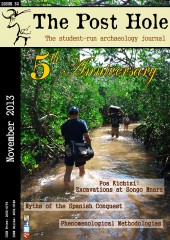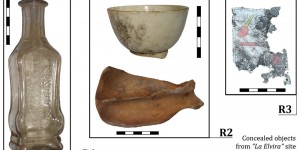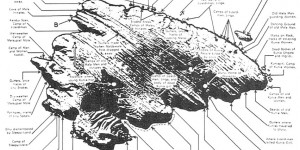This article will explore the possibility of the adaptive re-use of closed and disused urban churchyards as public spaces. This will be done by engaging with previous work on the subject, including the suggestions made in John Loudon’s seminal book of 1843, and by exploring the potential benefits and reasons for such an undertaking through looking at two of York’s defunct churchyards.
From its beginnings, historical graveyard archaeology has been influenced not only by the passionate interest of amateurs like genealogists and churchgoers, but by the academic fascination of the historians and archaeologists who have studied them. As far back as the year 1843, with John Loudon’s publication On the Laying Out, Planting and Managing of Cemeteries, it has been appreciated that grave markers are important historical records (Loudon 1843, 13). For many communities prior to the introduction of a national system of education, they may have been the only locally available source of written history. Despite attempts by church staff and clergymen to maintain proper records and grave plot maps, there is, almost without exception, a great deal of information missing from the cemetery records of many communities, both urban and rural.
The work of academics such as Dr. Harold Mytum has sought to rectify this, but without the widespread aid of the many communities for whom the graveyards were constructed, there is only so much to be done in a lifetime. The academic world has, unfortunately, moved onto more theoretical challenges. From beginnings in art history and genealogy, theories now abound on organising data sets, to collecting data from cemeteries as a sampling technique for demographic study (Mytum 2000, 47). The work presented by Mytum focuses more and more on theoretical aspects than on saving and preserving the graveyards and their monuments for posterity or for their value as unique landscape features with many potential uses (Mytum 2000, 48). In Ireland, the Irish Graveyard Surveyors have set themselves the mammoth task of recording every extant gravestone and memorial in the Republic of Ireland, and despite Herculean efforts, are struggling to conquer this task alone (IrishGraveyards.ie 2007). The communities served by churchyards are all too frequently concerned by their states of disrepair, but do not know how to go about tending or improving them (Albert 1994, 17). This situation can, and has led to many churchyards becoming neglected and derelict, and some that have been given attention have received the wrong kind of attention, with repairs affected by amateurs or without the necessary research to be done properly (Meller 1981, 17).
There is hope though, for the closed church and the disused churchyard. With the proper use of modern conservation techniques such as those laid out in Historic Scotland’s two-volume Guide for the Conservation of Graveyards, the old stones and their settings can be given new life, and bearing in mind some of the principles of John Loudon’s seminal work, can be put to new uses in a changing world.
This article will present, through the use of case studies and available academic publications, the case for the sympathetic redevelopment of full or disused churchyards, particularly in crowded cities, to allow their use as breathing space, a natural area for the enjoyment of the public, whilst still allowing their traditional values to be retained (Foramitti and Piperek 1975, 57). Traditional values incorporate their genealogical, religious, and cultural importance inherent not only in their monuments, but also in their churches, settings, and layout. I will start by looking at why urban churchyards in particular should be considered for this kind of adaptation to green space status, and how it can benefit those who live near them. An overview will be given of the ideas suggested by Loudon over a century and a half ago. I will then use the case studies to show what can be done, and make suggestions for future projects.
Loudon’s book recommended a wholesale reorganisation of the way in which cemeteries are laid out, in order to create pleasant paths and walking routes, whilst also retaining the original memorials for the purposes for which they were built (Loudon 1843, 11). It is my intention to show that the reuse of a graveyard can be a more laissez faire undertaking, with only minimal changes and maintenance required to transform a derelict graveyard into a pleasant landscape for public enjoyment. The options available include transfer to local authority care of the churchyard itself, which might be useful if the church is still active. This can also lead to the potential adoption of Nature Reserve or park status, allowing specialist care to be taken, and for wider use to be encouraged (Burman 1988, 89). The Churches Conservation Trust’s involvement might also be encouraged if the church is defunct, allowing once again for specialist care, but also encouraging the local community’s involvement through the CCT’s widespread use of volunteers. To show the scope and feasibility of these schemes, I will use case studies. My first will be Holy Trinity Church in Goodramgate, York, a defunct 13th century church which is now in the care of the Churches Conservation Trust. It is used as a tourist attraction, has a great volunteering base which attracts tourists and local visitors interested in the city’s history, and its churchyard provides through access to shopping areas, and a quiet space for relaxation and rest. My next case study is St Cuthbert’s Church, Durham, an active church with a full yard which is now under the Local Authority’s care, and has been given Nature Reserve status within the city itself, providing a novel attraction for local residents and visitors to the area. In support of these case studies, I will refer to the many guides and publications available on the subject, written by Historic Scotland and English Heritage amongst others.
Why Churchyards?
A great deal of work has been done in studying the psychological effects of living in urban environments. The studies undertaken for UNESCO by Foramitti and Piperek (1975) may be a little early, but it provides a fascinating insight into the mind of the city-dweller, and the potential problems which relentless urban exposure can cause (Foramitti and Piperek 1975, 46). Although I do not believe that an urban churchyard is enough to stave off psychological collapse, the green spaces of cities ought surely to be considered an essential and beneficial addition to any urbanised area. Specifically, they mention that older buildings, natural light and a secluded space are all important requirements for a healthier urban lifestyle (Foramitti and Piperek 1975, 47). This conclusion is supported by the Department for the Environment’s 1996 guide Greening the City, which mentions cemeteries specifically as an area which can be successfully converted into green space. The guide also suggests that such an improvement can have wider-ranging benefits than simply improving quality of life. They might also serve to develop an area economically through visitors, and provide a stronger community focal point for the local area as well. The lack of greenery and natural landscape in central London has been a concern for many years, and is part of the reason Abney Park cemetery became such a renowned arboretum and Highgate such a world-class landscape garden in the 19th and early 20th centuries (Meller 1981, 52). The connection with nature is one which provides comfort and reassurance to people with little or no contact with the countryside on a daily basis. Those visiting cemeteries in London and other large cities do so not only to visit the dead, but also to find a quiet, green space where they can escape the relentless drive of city life (Francis, Kellaher and Neophytou 2005, 208). The Victorians were well aware that fresh air, sunlight and green areas with plants were all beneficial to the lives of those who lived in increasingly polluted and choked cities (Meller, 1981, 51). This idea is one which has taken hold in some areas, with churchyards and their inherent green areas being used for the much needed peace and quiet they provide. The churchyard is, in a way, an instant park. It is already an open space, unpaved for the most part, and often contains trees and flowering plants around the site’s perimeter, especially if it is walled, as many are. The passive nature of a park or green means that it is the easiest of tasks to convert a churchyard, with only a minimum of effort in terms of the alteration of the space for this new purpose. With the additional interest of the monuments, architecture and atmosphere of a burial ground, its cultural and potentially its environmental importance, makes the churchyard an ideal candidate for conversion to park or Nature Reserve space.
Loudon’s Suggestions
John Loudon’s life was spent in travelling the world and learning his trade as a landscaper and gardener. His was a ‘classic’ Victorian style, now well known to the 21st century historian. His ideas were centred on calm, elegant beauty and natural landscapes in even the most sombre of locations (Loudon 1843, 12). His book On the Laying Out, Planting and Managing of Cemeteries contains an extensive section on the beautifying of graveyards and cemeteries. Although his inspiration came from notable cemeteries abroad, such as those of Istanbul and Paris’s Pere La Chaise, his interpretation of them was very much a British affair, and one of his main reasons for their redesign was to encourage good manners (Loudon 1843, 11). The designs he presented were filled with promenading couples, native British trees, and the book even contains an exhaustive list of suitable native species for planting. One of his many explanatory notes states that Britain deserves to have pleasant and attractive spaces for her dead, and that they should also facilitate enjoyment for the living, rather than fear and superstition (Loudon 1843, 9).
The sections which are of most interest to the matter at hand are those on the fixing in place, and relaying of monuments. A great deal of space is devoted to how memorials and monuments can be fixed in place. The major recommendations made by Loudon are that the monuments be bedded in a masonry foundation six inches deep, that the soil be allowed to settle before the stone is inserted, and that any stone which is in danger of falling over should be reinforced with non-ferrous dowelling or cleats (Loudon 1843, 29). Anyone who has taken the time to inspect a graveyard will doubtless have found lead cleats and steel rods inserted into at least one or two of the monuments therein. Unfortunately, the soft nature of lead means that these cleats often buckle, and causes even more damage to the stone they were designed to protect (Historic Scotland 2003, 9). Steel is extensively found in gravestone repairs, despite a one hundred and seventy year-old book recommending non-ferrous metal, as the rusting of steel not only discolours, but damages stones which contain such materials (Loudon, 1843, 29). The use of Loudon’s work might be suggested as a key text for anyone wishing to take care of a cemetery or graveyard, or engage in repairing them, as his sound advice on this matter has been widely ignored for nearly two centuries.
Loudon also looks at how stones can be moved and replaced to create a more enjoyable open space for the public to use. His concerns are less to do with the preservation of the memorials in context, and more with not walking across graves or the inhumed deceased (Loudon 1843, 39). Though this is an admirable and relevant concern, it misses one crucial aspect of graveyard conservation I wish to address: the plight of the gravestone. Although the respect of the remains in the graveyard is paramount, coming in a close second in the chain of concern is the respect of the memorials, and this is the conservation issue I will look at most in the course of this study.
Another of Loudon’s suggestions is the planting of flowers, trees and hedges in the graveyard, to allow not only beautification, but also the creation of a pleasant atmosphere, rather than the morbid, sombre environment often conjured up in the minds of Europeans when graveyards are mentioned (Loudon 1843, 12). This idea is one to be borne in mind when conserving graveyards, as plants and flowers provide much needed habitats for wildlife, but can also cause damage to monuments through the spread of root systems and lichenous growth.
This all illustrates how the graveyards of today, whether derelict, crowded, full or closed, can all be put not to a new use, but to an adaptation of their original purpose. Put simply, in Loudon’s own words:
“Churchyards serve to improve morals and taste, cultivate the intellect botanically, and act as historical records.” (Loudon 1843, 13).
Bibliography
- Albert, B. (1994) Adaptive Church Reuse. Buffalo: University of New York, University at Buffalo.
- Burman, P. (1988) The Churchyards Handbook. London: Church House Publishing.
- Foramitti, H. and Piperek, M. (1975) Anxieties of City Dwellers. In UNESCO (ed). The Conservation of Cities. Paris: UNESCO Press. 43-56.
- Francis, D., Kellaher, L. and Neophytou, G. (2005) The secret cemetery. Oxford: Berg.
- GFA Consulting. (1996) Greening the city: a guide to good practice. London: H.M. Stationery Office.
- Historic Scotland. (2001) Conservation of historic graveyards. Edinburgh: Historic Scotland.
- Historic Scotland. (2002) Conservation of historic graveyards. Edinburgh: Historic Scotland.
- Historic Scotland. (2003) Emergency measures for historic memorials. Edinburgh: Historic Scotland.
- Irish Graveyard Surveyors. (2007) Irishgraveyards.ie. [Online]. Irish Graveyard Surveyors. Available at: http://www.irishgraveyards.ie [Accessed 21 January 2013].
- Loudon, J. (1843) On the laying out, planting and managing of cemeteries. Redhill: Ivelet.
- Meller, H. (1981) London cemeteries. Amersham: Avebury.
- Mytum, H. (2000) Recording and analysing graveyards. York: CBA.








